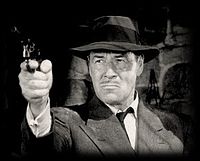Holt of the Secret Service
| Holt of the Secret Service | |
|---|---|
 | |
| Directed by | James W. Horne |
| Screenplay by | Basil Dickey George H. Plympton (as George Plympton) Wyndham Gittens |
| Produced by | Larry Darmour |
| Starring | Jack Holt Evelyn Brent |
| Narrated by | Knox Manning |
| Cinematography | James S. Brown Jr. |
| Edited by | Dwight Caldwell Earl Turner |
| Music by | Lee Zahler |
Production company | Columbia Pictures |
| Distributed by | Columbia Pictures |
Release date |
|
Running time | 278 minutes (15 episodes) |
| Country | United States |
| Language | English |
Holt of the Secret Service (1941) was the 16th serial released by Columbia Pictures.
Plot
[edit]A murderous gang of counterfeiters has kidnapped John Severn (played by Ray Parsons), the U.S. government's best engraver. He is forced to engrave a set of counterfeit plates, to print phony money that is virtually undetectable from genuine currency. The United States Secret Service sends its toughest agent, Jack Holt (played by himself), and his female partner, Kay Drew (Evelyn Brent), after the gang. Holt poses as escaped tough guy, Nick Farrel. Masquerading as the bickering, tough-talking Mr. and Mrs. Farrel, Holt and Drew manage to infiltrate the ruthless gang of thugs. Holt locates Severn and instructs him to keep working but as slowly as possible, to give Holt time to find the head of the crime ring. Holt takes the set of counterfeit plates in hand, and much of the action has Holt keeping the plates away from the crooks. The scenes shift from the gang's hideout in a lost canyon to a gambling ship on the high seas, to a small island country where the gang hopes to escape U.S. extradition.
The head of the ring is gambler Lucky Arnold (John Ward), but he hides behind the facade of one of his loyal henchmen, Quist (Ted Adams), to shield himself from the Secret Service, and lets another one of his men, Ed Valden (Tristram Coffin), do most of his dirty work. The island nation has its own self-appointed dictator (Stanley Blystone), who is also trying to rub out our hero. During the 15 episodes, Holt endures numerous brushes with death, emerging from all of them virtually unscathed. Holt is so tough that, when he faces a firing squad and is asked if he wants a blindfold, he murmurs, "Forget it. This is the only thing in life I haven't seen!"
Cast
[edit]- Jack Holt as Jack Holt / Nick Farrel
- Evelyn Brent as Kay Drew - R49
- C. Montague Shaw as Chief John W. Malloy (as Montague Shaw)
- Tristram Coffin as Ed Valden [Chs. 1-10]
- John Ward as 'Lucky' Arnold
- Ted Adams as Quist
- Joe McGuinn as 'Crimp' Evans
- Edward Hearn as Agent Jim Layton
- Ray Parsons as John Severn - Engraver [Chs. 1-4]
- Jack Cheatham as Agent Frank [Chs. 3-5, 8-9, 15]
Chapter titles
[edit]
- Chaotic Creek
- Ramparts of Revenge
- Illicit Wealth
- Menaced by Fate
- Exits to Terror
- Deadly Doom
- Out of the Past
- Escape to Peril
- Sealed in Silence
- Named to Die
- Ominous Warnings
- The Stolen Signal
- Prison of Jeopardy
- Afire Afloat
- Yielded Hostage
Production
[edit]Jack Holt, Columbia's star of longest standing, had argued with studio head Harry Cohn. Cohn demoted him from working in feature films to this lowbrow serial adventure. Actually, it wasn't so much of a demotion because he was still working with the same feature-film crew, under producer Larry Darmour. Holt had misgivings about working in a serial, but was convinced by co-star Evelyn Brent to see it through. She knew that Darmour was making the serial for an adult audience, by making it thrilling and logical but never impossible.[1] Darmour was also careful to cast the film with character actors who were not familiar from Darmour's serials.
Reception
[edit]Holt of the Secret Service turned out to be exceptionally successful in theaters, with the Jack Holt name attracting fans of action and adventure. By the time it was released, Holt had left the studio behind and there were no sequels.
After the serial's copyright lapsed in 1969, Holt of the Secret Service became one of the very few Columbia cliffhangers available for modern appraisal. Authors and critics marveled at the film's breakneck pace and hectic, six-against-one fight scenes as staged by former comedy director James W. Horne. Thus Holt of the Secret Service became the poster child for Columbia serials until the advent of home video, when more of the Columbia serials went into circulation.
Notes
[edit]- ^ p.108 Kerr, Lynn & King, James Evelyn Brent: The Life and Films of Hollywood's Lady Crook McFarland
Sources
[edit]External links
[edit]- Holt of the Secret Service at IMDb
- Holt of the Secret Service is available for free viewing and download at the Internet Archive
- Holt of the Secret Service at AllMovie
